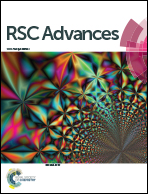Synthesis of hexagonal mesoporous silicates functionalized with amino groups in the pore channels by a co-condensation approach
Abstract
Mesoporous silicates functionalized with amino groups in the pore channels have been made by the co-condensation of tetraethoxyl siloxide (TEOS) with precursors of P–Si through a triblock copolymer-templated sol–gel process under acidic conditions. Poly(alkylene oxide) block copolymer (P123) was eluted by ethanol extraction and template molecules were removed by refluxing the materials in a mixture of DMSO and water. The resulting materials were characterized in detail by FT-IR, XRD, TEM and N2 adsorption, in order to study the effect of the precursors on the mesoscopic order and pore structure. Evidence of amino groups located in the pore channels was shown through variation of pore size and BET surface area after the amino groups were coupled with benzaldehyde, and TEM images of materials after staining with RuO4. Finally, a comparative study of the catalytic performance of materials SBA-Am-10 and SBA-T-10, obtained by two methods, revealed that the catalyst synthesized by our method gave rapid reaction speed and high yields of flavanone by the Claisen–Schmidt condensation of benzaldehyde and 2′-hydroxyacetophenone.


 Please wait while we load your content...
Please wait while we load your content...